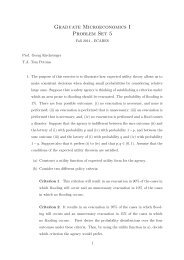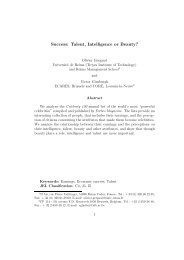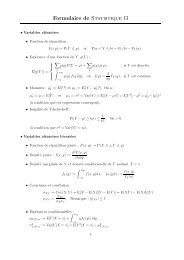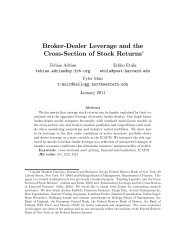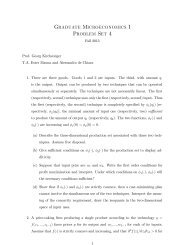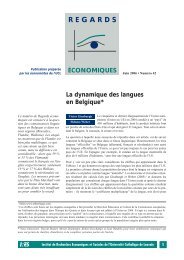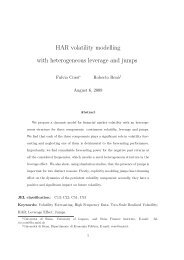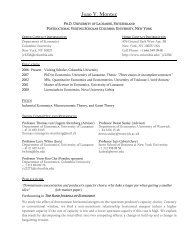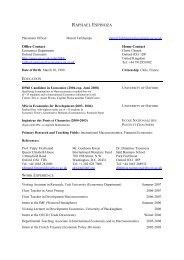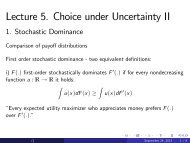Switching Costs in Two-sided Markets - Ecares
Switching Costs in Two-sided Markets - Ecares
Switching Costs in Two-sided Markets - Ecares
- No tags were found...
Create successful ePaper yourself
Turn your PDF publications into a flip-book with our unique Google optimized e-Paper software.
Consider the symmetric equilibrium such that p A 0,1 = pA 1,1 and pB 0,1 = pB 1,1 , so thatn A 0,1 = nB 0,1 = 1 2 (hence λ i = 0). Then, we simplify the first-order conditions and solvesimultaneously for p A 0,1 and pB 0,1 .p i 0,1 = 1 − κ iτ i− σ jτ j− e j − δ F ξ i .The discussion is summarized <strong>in</strong> the follow<strong>in</strong>g proposition.Proposition 4. The two-period two-<strong>sided</strong> s<strong>in</strong>gle-hom<strong>in</strong>g duopoly model, where on eachside a proportion α i of the consumers are naive while the rema<strong>in</strong><strong>in</strong>g consumers aresophisticated, and a fraction µ i of the consumers have fixed preferences while the othershave <strong>in</strong>dependent preference, has a symmetric equilibrium. The first-period equilibriumprices for group A and group B are given respectively byp A 0,1 = 1 − κ Aτ A− σ Bτ B− e B − δ F ξ A ;p B 0,1 = 1 − κ Bτ B− σ Aτ A− e A − δ F ξ B , (3)and <strong>in</strong> the second period, each platform’s equilibrium pric<strong>in</strong>g strategies are given byp A 0,2 = 1 − e B(1 − µ A )1 − µ A; p B 0,2 = 1 − e A(1 − µ B )1 − µ B.In equilibrium, the second-period pric<strong>in</strong>g strategies is computed by substitut<strong>in</strong>g symmetricmarket shares <strong>in</strong>to Equations (1) and (2).3 DiscussionThe analysis of the effect of switch<strong>in</strong>g costs on first-period prices is complicated asp A 0,1 and pB 0,1 are long expressions with many variables. An easier way to <strong>in</strong>terpret theresults is to start the discussion from pure switch<strong>in</strong>g-cost model (à la Klemperer) andpure two-<strong>sided</strong> model (à la Armstrong), and then extend to mixed models with different<strong>in</strong>gredients.3.1 Pure <strong>Switch<strong>in</strong>g</strong>-cost ModelIn the simplest two-period model of switch<strong>in</strong>g costs with two symmetric firms, zeromarg<strong>in</strong>al costs, and undifferentiated competition, the firms know<strong>in</strong>g that they can exerciseits ex post market power <strong>in</strong> the second period over those consumers who are locked-<strong>in</strong>(p 2 = s), they are will<strong>in</strong>g to price below cost (p 1 = −δs) <strong>in</strong> the first period to acquirethese valuable customers. Consumers foresee<strong>in</strong>g the possibility of be<strong>in</strong>g exploited <strong>in</strong>the future will become more <strong>in</strong>different between the two compet<strong>in</strong>g firms, and the onlyth<strong>in</strong>g that matters to them is today’s price. This implies that even rational consumersbehave <strong>in</strong> a naive way, and this is equivalent to sett<strong>in</strong>g δ i , α i = 0 <strong>in</strong> the current model. 44 Note that one can <strong>in</strong>terpret δ i(1 − α i) as a measure of rationality <strong>in</strong> the current analysis.11



